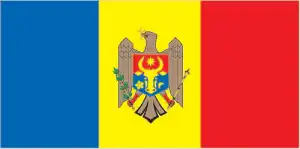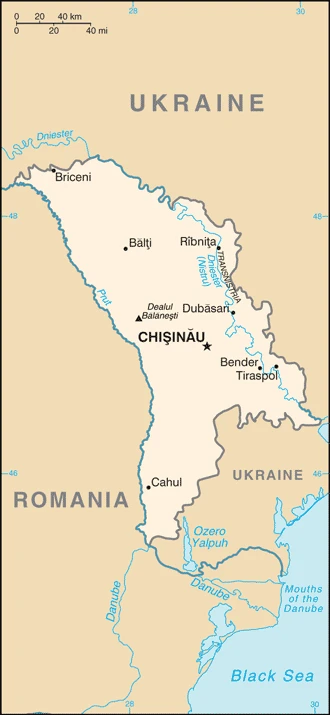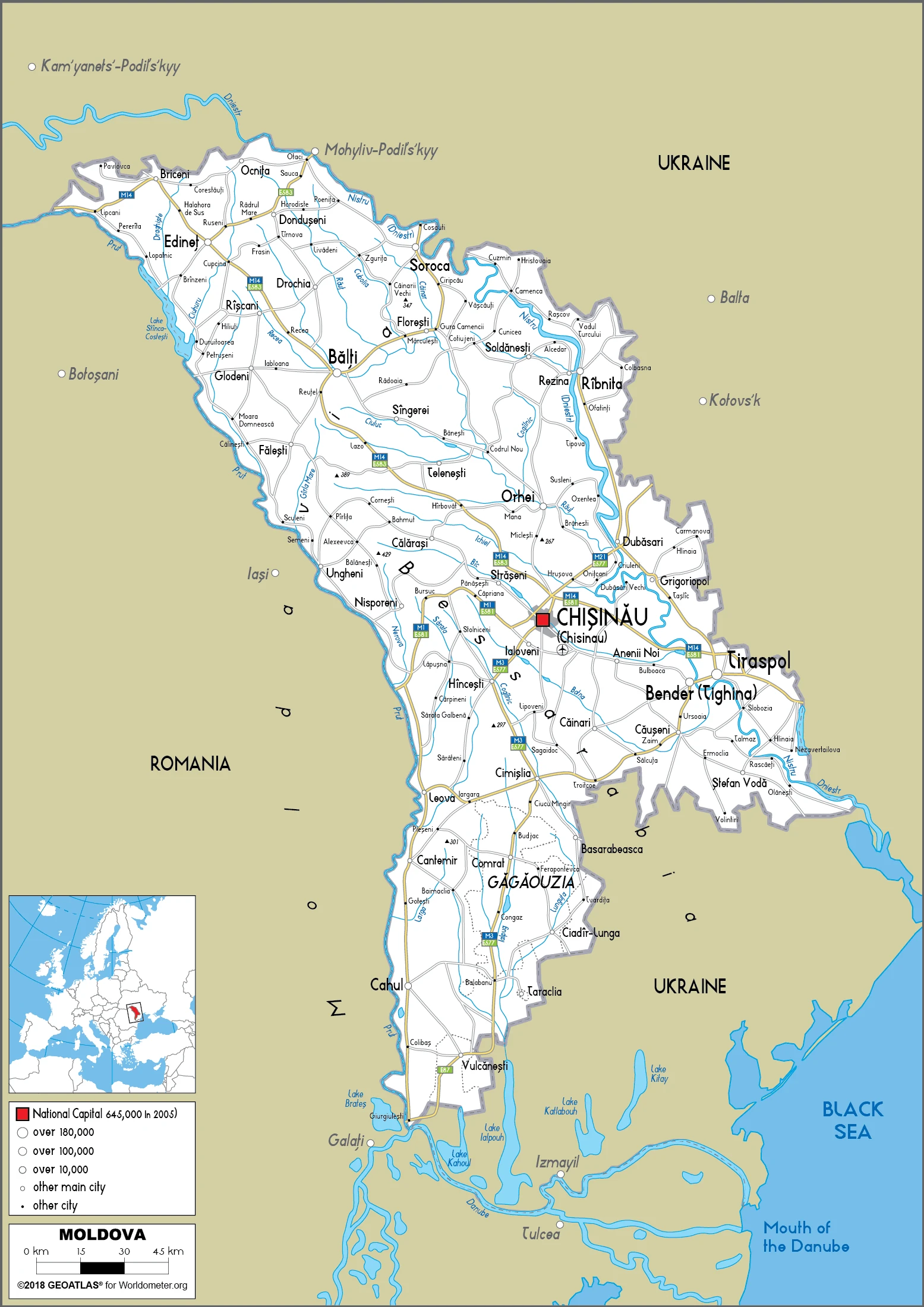Moldova Google Maps is a site/tool that offers a wide range of map views (topographic, satellite, street view) and navigation options, with little effort on your part, yet efficiently. If you need to plan a trip to a new place like Moldova, Google maps are available on desktop, mobile, or tablet. This Google maps and information page is dedicated to Moldova, Europe (47 countries), showing its location, country facts, details about its capital city Chisinau, bordering countries like Romania Ukraine, and plenty of other information which may be interesting when you visit this European state.
Quick links: Google Maps Moldova, Chisinau Google maps, Driving Directions Moldova, Printable Road Map.

About Moldova in a nutshell
- Conventional short form of the name: Moldova
- The conventional long form of the name: Republic of Moldova
- Local long form: Republica Moldova
- Local short form: Moldova
- Former name(s): Moldavian Soviet Socialist Republic, Moldovan Soviet Socialist Republic
- Etymology: named for the Moldova River in neighboring eastern Romania.
- The legal system in Moldova: civil law system with Germanic law influences; Constitutional Court review of legislative acts.
- Climate: Warm summers and relatively mild winters. Moderate rainfall is evenly spread throughout the year.
- The national symbols are aurochs (a type of wild cattle); national colors: blue, yellow, red.
- Internet TLD: .md
Across the Carpathians, in the low hinterland between the Prut and the Dniester, isolated from the sea, Bessarabia’s main natural treasure is its fertile floodplain soils. The densely populated countryside has long since been deforested, but its verdant vineyards and yellowing sunflower fields give the landscape a picturesque appearance. Hiding in the rain-shadow of the Carpathians, the climate is moderately arid, but the Podolian foothills and the rivers that collect the waters of the Eastern Carpathians often flood. There are several autonomous republics in the multi-ethnic country: Gagauzia is inhabited by a Turkish-speaking Christian community, while the Russian-speaking Transnistrian region seceded from Moldova in 1990. Currently, the only World Heritage site in the country, the Struve survey network of landmarks runs along the Dniester Valley. But that is probably not why tourists will visit Moldova.
The capital, Chijinau, is situated on the banks of the Bac (Byk) River; some of the old buildings and churches of the city, which suffered heavy damage during the Second World War, are still intact. The former Kisinyov gives the impression of a small town in the Romanian countryside. Cricova, to the north of the capital, is a starting point for wine tours. Authentic street names help you find your way around the underground labyrinth of wine cellars: walk along Cabernet Street, and you will come to Pinot Street. And for a more “liverwurst” experience, Capriana’s 14th-century monastery, still in operation today, offers a genuine spiritual retreat with its three Baroque churches and 22 Orthodox monks.
Vast underground wine vaults contain entire “streets” of bottles built into rock quarries.
Background
A large portion of present-day Moldovan territory became a province of the Russian Empire in 1812 and then unified with Romania in 1918 in the aftermath of World War I. This territory was then incorporated into the Soviet Union at the close of World War II. Although Moldova has been independent of the Soviet Union since 1991, Russian forces have remained on Moldovan territory east of the Nistru River in the breakaway region of Transnistria, whose population is roughly equally composed of ethnic Ukrainians, Russians, and Moldovans. Years of Communist Party rule in Moldova from 2001-2009 ultimately ended with election-related violent protests and a rerun of parliamentary elections in 2009. Since then, a series of pro-European ruling coalitions have governed Moldova. As a result of the country’s most recent legislative election in February 2019, parliamentary seats are split among the left-leaning Socialist Party (35 seats), the former ruling Democratic Party (30 seats), and the center-right ACUM bloc (26 seats). Parliament voted in Prime Minister Ion CHICU and his cabinet on 14 November 2019, two days after voting to remove his predecessor, ACUM co-leader Maia SANDU, who had been in office since June 2019.
Geography
Steppes and hilly plains are drained by the Dniester and Prut rivers.

The most densely populated of the former Soviet republics, Moldova has strong ethnic, linguistic, and cultural links with Romania, but relations with Russia remain paramount.
This state is located in Eastern Europe, northeast of Romania, under the coordinates of 47 00 N, 29 00 E, covering an area of 33,851 sq km with a coastline of 0 km (landlocked country). Moldova is Slightly larger than Maryland.
Moldova has 1,885 km of land boundaries in total and borders with (2 nations): Romania 683 km, Ukraine 1202 km.
Rolling steppe, gradual slope south to the Black Sea, with Dealul Balanesti 430 m as the highest point of Moldova, while Dniester (Nistru) 2 m as the lowest point, causing a mean elevation at 139 m throughout the country. With a total of 33,851 sq km, Moldova has 32,891 sq km of land and 960 sq km water surface area.
Major rivers are the Danube (shared with Germany, Austria, Slovakia, Czechia, Hungary, Croatia, Serbia, Bulgaria, Romania, and Ukraine) – 2,888 km, Dniester (shared with Ukraine) – 1,411 km. The significant watersheds for Moldova are Atlantic Ocean drainage: (Black Sea) Danube (795,656 sq km).
Landlocked; well endowed with various sedimentary rocks and minerals, including sand, gravel, gypsum, and limestone.
The climate in Moldova is as follows: Moderate winters warm summers.
When you visit Moldova, the natural hazards shall be considered: Landslides.
The following major health-threatening issues shall be considered when visiting Moldova: none.
Current environmental issues affecting the Moldovan people: heavy use of agricultural chemicals, has contaminated soil and groundwater, extensive soil erosion, and declining soil fertility from poor farming methods.
Google Maps Moldova
The capital and other divisions
Capital city: Chisinau found under the coordinates 47 00 N, 28 51 E, applying the time zone UTC+2 (7 hours ahead of Washington, DC, during Standard Time), using the following daylight saving time: +1hr, begins last Sunday in March; ends last Sunday in October.
Chisinau is the capital and largest city of the Republic of Moldova, with a population of 275,158. Chisinau is the only major city in Moldova. The country’s official languages are Romanian and Moldovan. The city’s name derives from the meaning “old town” and stems from its first settlement dating back to 1337 as an essential trade town between the Principality of Moldavia and Wallachia. It was renamed Kishinev in 1862 by the Russian Empire to prevent confusion with another city in Ukraine; this name remained until 1924, when it reverted to its original form. It became the capital of Soviet Moldavia in 1940 after the Soviet Union gained control.
Moldova became independent on 27 August 1991 (from the Soviet Union), and its national holiday is Independence Day, 27 August (1991).
Administrative divisions: 32 raions (raioane, singular – raion), 3 municipalities (municipii, singular – municipiul), 1 autonomous territorial unit (unitatea teritoriala autonoma), and 1 territorial unit (unitatea teritoriala) raions: Anenii Noi, Basarabeasca, Briceni, Cahul, Cantemir, Calarasi, Causeni, Cimislia, Criuleni, Donduseni, Drochia, Dubasari, Edinet, Falesti, Floresti, Glodeni, Hincesti, Ialoveni, Leova, Nisporeni, Ocnita, Orhei, Rezina, Riscani, Singerei, Soldanesti, Soroca, Stefan Voda, Straseni, Taraclia, Telenesti, Ungheni municipalities: Balti, Bender, Chisinau autonomous territorial unit: Gagauzia territorial unit: Stinga Nistrului (Transnistria).
People and society
A shared heritage with Romania defines a national identity, though, in 1994, Moldovans voted against possible reunification with Romania. Most of the population is engaged in intensive agriculture. Transnistria is a breakaway state along the east bank of the Dniester, home to a large ethnic Slav population. The Gagauz, in the south, have accepted autonomy.
The population in Moldova is 3,323,875 (July 2021 estimate), with an average of -1.1% (2021 estimate) change. That means Moldova is the No. 133 in the world’s populated rank list. With an average of 37.7 years median age (36.2 years for males and 36.2 years for women), Moldova ranks No. 68 on the globe’s median age rank list.
The people living in this country are the Moldovan(s) (noun) or Moldovan (adjective) and belong mainly to the following ethnic groups: Moldovan 75.1%, Romanian 7%, Ukrainian 6.6%, Gagauz 4.6%, Russian 4.1%, Bulgarian 1.9%, other 0.8% (2014 estimate).
They speak Moldovan/Romanian 80.2% (official language) (56.7% identify their mother tongue as Moldovan, which is virtually the same as Romanian; 23.5% identify Romanian as their mother tongue), Russian 9.7%, Gagauz 4.2% (a Turkish language), Ukrainian 3.9%, Bulgarian 1.5%, Romani 0.3%, other 0.2% (2014 estimate); languages and practice the following religions: Orthodox 90.1%, other Christian 2.6%, other 0.1%, agnostic <.1%, atheist 0.2%, unspecified 6.9% (2014 estimate). We can conclude the following about the population in Moldova: Pockets of agglomeration exist throughout the country, the largest being in the center of the country around the capital of Chisinau, followed by Tiraspol and Balti. In Moldova, we are talking about 43% (2021) of the total population is living in cities, and most of them reside in the following municipalities: 494,000 Chisinau (capital city) (2021).
Industry
The poorest country in Europe. Mainly agricultural: produces wine, tobacco, fruit. Food processing and textiles. Depends on Russia for raw materials, fuel, exports. Political instability.
Despite recent progress, Moldova remains one of the poorest countries in Europe. With a moderate climate and productive farmland, Moldova’s economy relies heavily on its agriculture sector, featuring fruits, vegetables, wine, wheat, and tobacco. Moldova also depends on annual remittances of about $1.2 billion – almost 15% of GDP – from the roughly one million Moldovans working in Europe, Israel, Russia, and elsewhere., With few natural energy resources, Moldova imports almost all its energy supplies from Russia and Ukraine. Moldova’s dependence on Russian energy is underscored by a more than $6 billion debt to Russian natural gas supplier Gazprom, largely the result of unreimbursed natural gas consumption in the breakaway region of Transnistria. Moldova and Romania inaugurated the Ungheni-Iasi natural gas interconnector project in August 2014. The 43-kilometer pipeline between Moldova and Romania allows for the import and export of natural gas. Several technical and regulatory delays kept gas from flowing into Moldova until March 2015. Romanian gas exports to Moldova are largely symbolic. In 2018, Moldova awarded a tender to Romanian Transgaz to construct a pipeline connecting Ungheni to Chisinau, bringing the gas to Moldovan population centers. Moldova also seeks to connect with the European power grid by 2022.
The government’s stated goal of EU integration has resulted in some market-oriented progress. Moldova experienced better than expected economic growth in 2017, driven mainly by increased consumption, increased revenue from agricultural exports, and improved tax collection. During fall 2014, Moldova signed an Association Agreement and a Deep and Comprehensive Free Trade Agreement with the EU (AA/DCFTA), connecting Moldovan products to the world’s largest market. The EU AA/DCFTA has contributed to significant growth in Moldova’s exports to the EU. In 2017, the EU purchased over 65% of Moldova’s exports, a significant change from 20 years previously when the Commonwealth of Independent States (CIS) received over 69% of Moldova’s exports. A $1 billion asset-stripping heist of Moldovan banks in late 2014 delivered a significant shock to the economy in 2015; the subsequent bank bailout increased inflationary pressures and contributed to the depreciation of the leu and a minor recession. Moldova’s growth has also been hampered by endemic corruption, which limits business growth and deters foreign investment, and Russian restrictions on imports of Moldova’s agricultural products. The government’s push to restore stability and implement meaningful reform led to the approval in 2016 of a $179 million three-year IMF program focused on improving the banking and fiscal environments, along with additional assistance programs from the EU, World Bank, and Romania. Moldova received two IMF tranches in 2017, totaling over $42.5 million., Over the longer term, Moldova’s economy remains vulnerable to corruption, political uncertainty, weak administrative capacity, vested bureaucratic interests, energy import dependence, Russian political and economic pressure, heavy dependence on agricultural exports, and unresolved separatism in Moldova’s Transnistria region.
Moldova is rich in natural resources: Lignite, phosphorites, gypsum, limestone, arable land.
The main industrial sectors are sugar processing, vegetable oil, food processing, agricultural machinery, foundry equipment, refrigerators, freezers, washing machines, hosiery, shoes, and textiles.
The country’s export sectors are powerful in insulated wiring, sunflower seeds, wine, corn, seats (2019), partnering with these nations: Romania 27%, Russia 9%, Italy 9%, Germany 9%, Turkey 6%, Poland 5% (2019). The export trade resulted in $3.24 billion. Note: Data are in current year dollars (2020 estimate). In a global rank of the export, values resulted in Moldova’s position of 142.
Land use in Moldova: 11.9% (2018 estimate) forest, 13.2% (2018 estimate) other.
The arable land area is 55.1% (2018 estimate), and the agricultural land is 74.9% (2018 estimate). Land use for permanent crops 9.1% (2018 estimate), permanent pasture 10.7% (2018 estimate). The sum of the area of the irrigated land is 2,283 sq km (2012).
The main agro-industrial products of Moldova are maize, wheat, sunflower seed, grapes, apples, sugar beet, milk, potatoes, barley, plums/sloes.
The country typically needs to import: refined petroleum, cars, insulated wiring, packaged medicines, broadcasting equipment (2019), partnering with the following nations: Romania 20%, Russia 10%, Ukraine 9%, Germany 8%, China 7%, Turkey 6%, Italy 6% (2019) in a sum value of $5.93 billion. Note: data are in current year dollars (2020 estimate) $6.62 billion. Note: data are in current year dollars (2019 estimate) $6.39 billion. Note: data are in current year dollars (2018 estimate). This sum value on the global ranking list of imports resulted in Moldova 132.
Moldova Driving Directions
In this post, you learned about Moldova, Eastern Europe, northeast of Romania. We published some basic information about its capital Chisinau, and the Moldovan nation.
Are you interested in visiting Moldova and looking for driving directions? Click here to plan your route, or see a printable road map of Moldova below for an overview of the route network.
Printable map of Moldova
Did you know about Moldova?
Moldova is a small country in Eastern Europe with a population of 3.6 million. It borders Romania and Ukraine, but they are not two of its closest neighbors. Moldova is an inferior place, and it has the third-highest rate of child poverty in Europe. They also have the smallest surface area of any European country, so they don’t have many natural resources to use for trade.
The geography of Moldova means that it doesn’t have many natural resources to use for trading. However, it has some natural resources like coal, wine grapes, and timber, which could be used to sell to other countries or companies instead of using them all in Moldova. Coal is one of their natural resources that can be sold to other countries because it can be used as fuel for power plants and heating homes throughout the winter months.
After virtually visiting Moldova, you may also be interested in the neighboring countries: Romania, Ukraine.
If you liked our Google map and Moldova information page,
please share it with others or save the link https://www.drivingdirections.net in your bookmarks.

